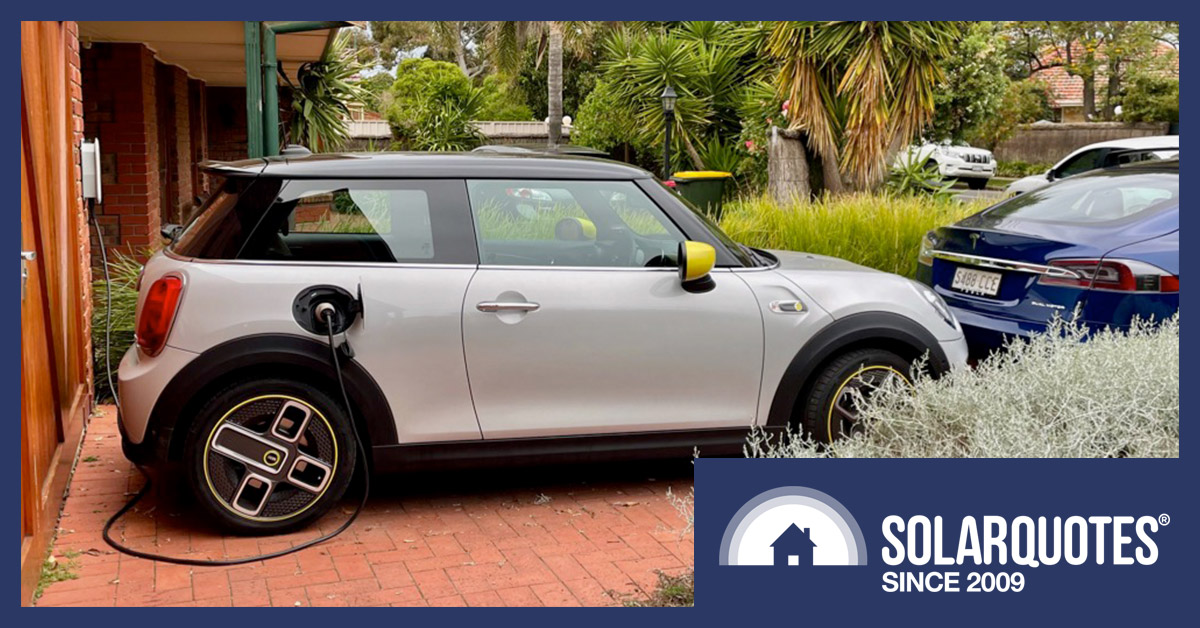
How fast can I charge my electric car at home?
The answer depends on what you plug it into. It can also depend on which EV you have.
The main options for home EV charging are…
- A regular Australian powerpoint: ~ 10 km of range per hour.
- A single-phase hard-wired EV charger: ~ 45 km of range per hour.
- A three-phase hard-wired EV charger: ~ 70 km of range per hour (but some can charge at ~140 km per hour).
If you don’t want to charge at home, you can always use a public charger. With a powerful, ultra-fast charger, and the right EV — such as the Hyundai Ioniq 5 Long Range — it’s possible to get 100km of range in five minutes1. Charging that fast is great for long trips or emergencies, but you’ll mostly want to charge at home because it’s better for the battery and a lot cheaper. The last time I used a Tesla supercharger it cost me 52 cents per kilowatt-hour. Charging with rooftop solar or off-peak electricity is a hell of a lot cheaper.
In this article, I’ll walk you through your home charging options. Then I’ll estimate specific single-phase and three-phase home charging speeds for every popular EV sold in Australia, as well as a few unpopular ones.
Three Levels Of EV Charging
EV charging is divided into three levels of increasing power. Only the first two are available for household use, unless your home has an industrial level power supply for some reason2.:
- ⚡️ Level 1: A normal household powerpoint3.
- ⚡️⚡️ Level 2: A dedicated home EV charger installed on a wall. These can be wired to single-phase or 3-phase power.
- ⚡️⚡️⚡️ Level 3 Charging: These are powerful public chargers that supply DC power. Ultra-fast ones can supply up to 350 kilowatts.
I’m focusing on home charging, so I’ll only go into detail on the first two.
⚡️Level 1 Charging
This is the simplest way to charge. You just plug one end of the level one charger cable into a powerpoint and the other end into the EV. If the plugs on a level one connector don’t fit, try turning it around.
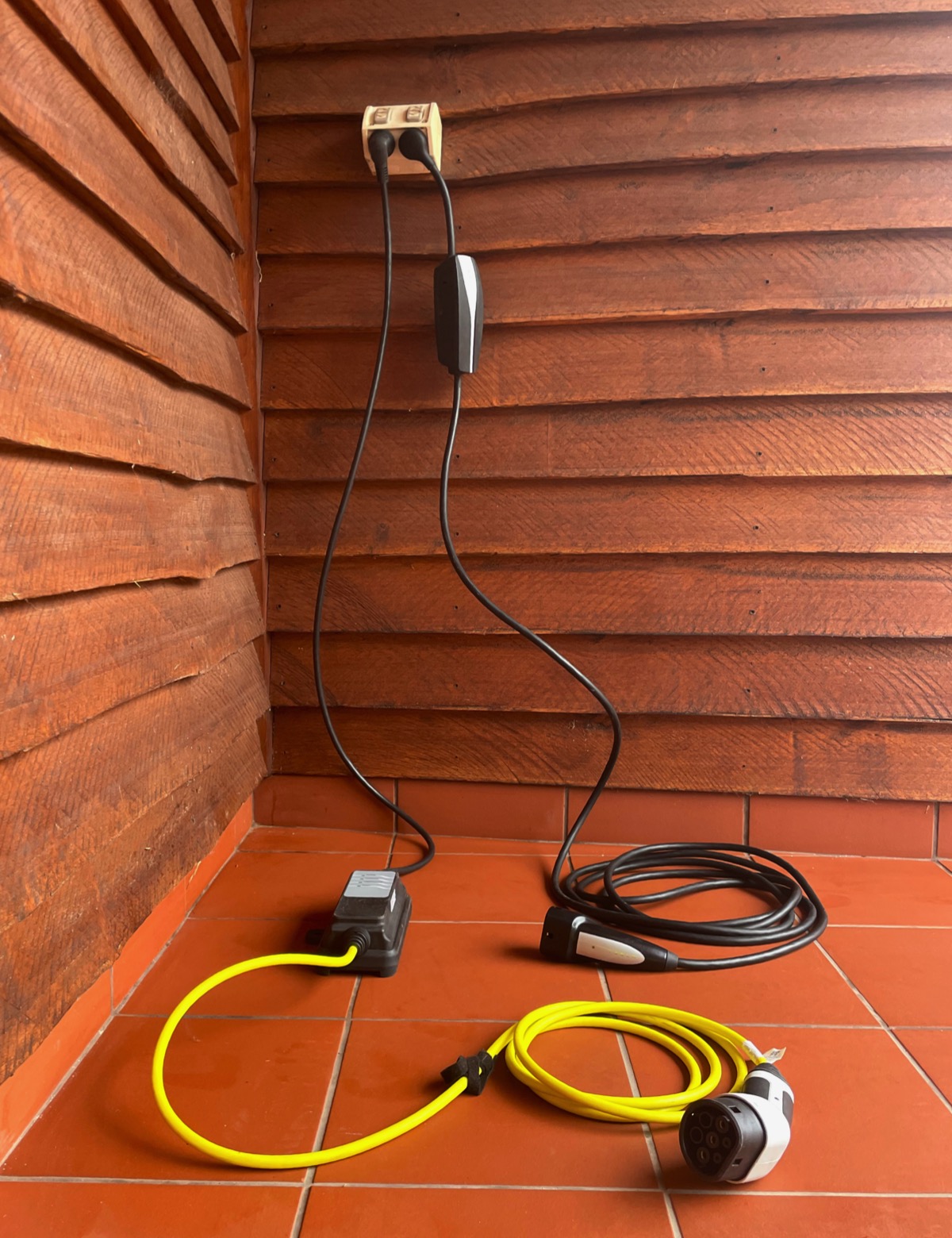
Two mobile chargers. The yellow one is for a Mini Cooper SE, the other for a Tesla. Never plug 2 car chargers into the same socket and use them at the same time or you’ll likely trip the breaker. If the breaker doesn’t trip you’ll be right on the edge of the rated current for the socket and wiring. Don’t do it. If you really want to charge 2 electric vehicles at the same time using their mobile chargers, get an electrician in to advise the safest way to do it in your property.
To ensure the EV can make full use of the available current, and also for extra safety, don’t plug anything else into the powerpoint. If two powerpoint sockets are next to each other, they will probably be on the same circuit, so leave the second one empty.
Every EV manufacturer should include a Level 1 adapter cable with the car.
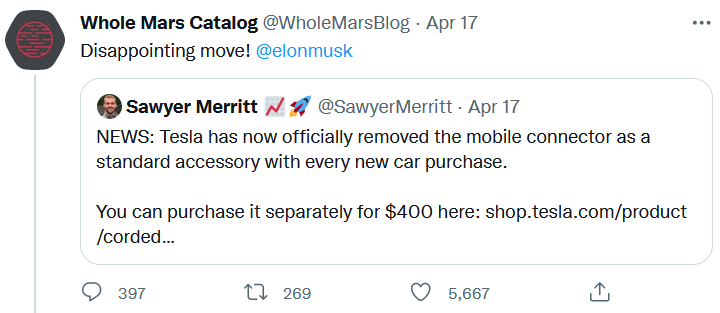
Goddammit, Elon!
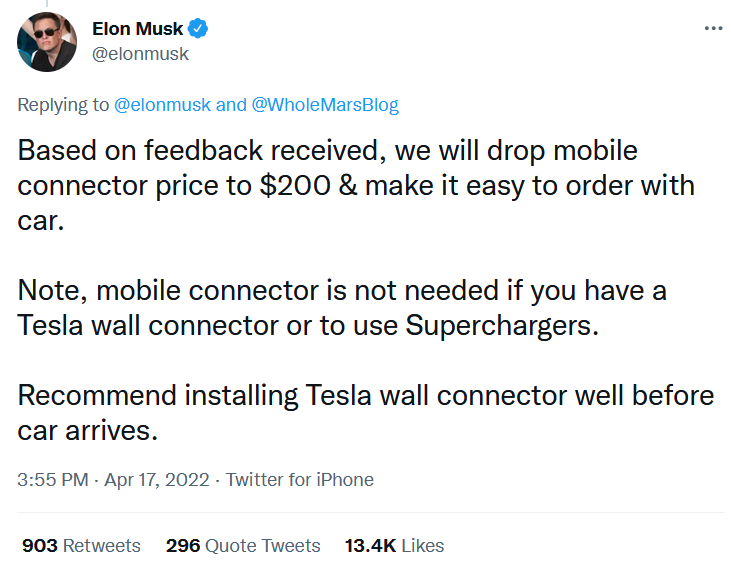
You’ll lower the Level 1 cable to $200 US? Christ, there’s only about $20 US worth of copper in one of them. And at the moment you’re still charging $860 for them in Australia.
While plugging into a regular powerpoint is simple, the charge rate is slow. Generally, it will only charge at 1.5 kilowatts; enough to add around 10 km of range per hour. The exact amount will depend on how efficient the car is when driven and how efficient it is at Level 1 charging.
Level 1 Charging Times
Let’s say you buy a Tesla Model 3 SR+ EV and then spend hours hooning around town, showing off your impeccable taste to your peccable friends. Finally, you arrive home with the battery almost completely drained. If you use a regular powerpoint to provide Level 1 charging, how long will it take to go from next to nothing to fully charged?
Tesla says its “Gen 2 Universal Mobile Connector” will let it charge at 1.9 kilowatts. Assuming level 1 charging is 83% efficient, it will add 12km of range per hour and would take 37 hours to fully charge the battery pack’s 57.5 kilowatt-hours of usable storage.
That’s a long time, but not nearly as bad as some assume. Normal people don’t need to fully charge their EV every day. The average Australian passenger car is driven around 38km per day. This means an average of a little over 3 hours Level 1 charging a day will be enough to keep it topped up.
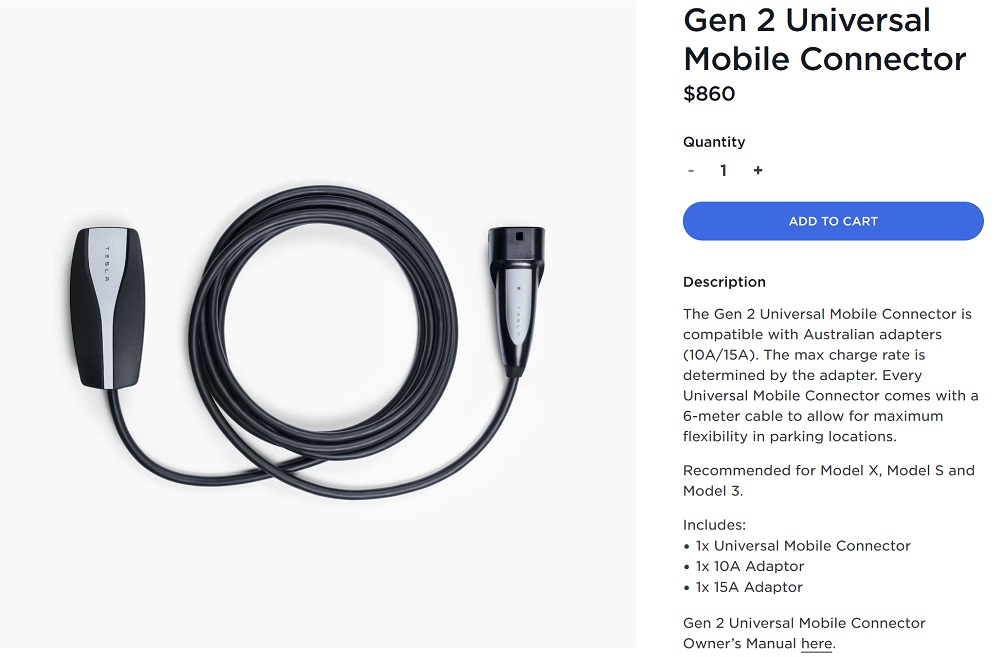
The Tesla connector for level 1 charging is currently being sold in Tesla’s Australian online store for the ridiculous and shameful price of $860.
⚡️⚡️Level 2 Charging
A level 2 charger is normally installed on a wall and can look like this:
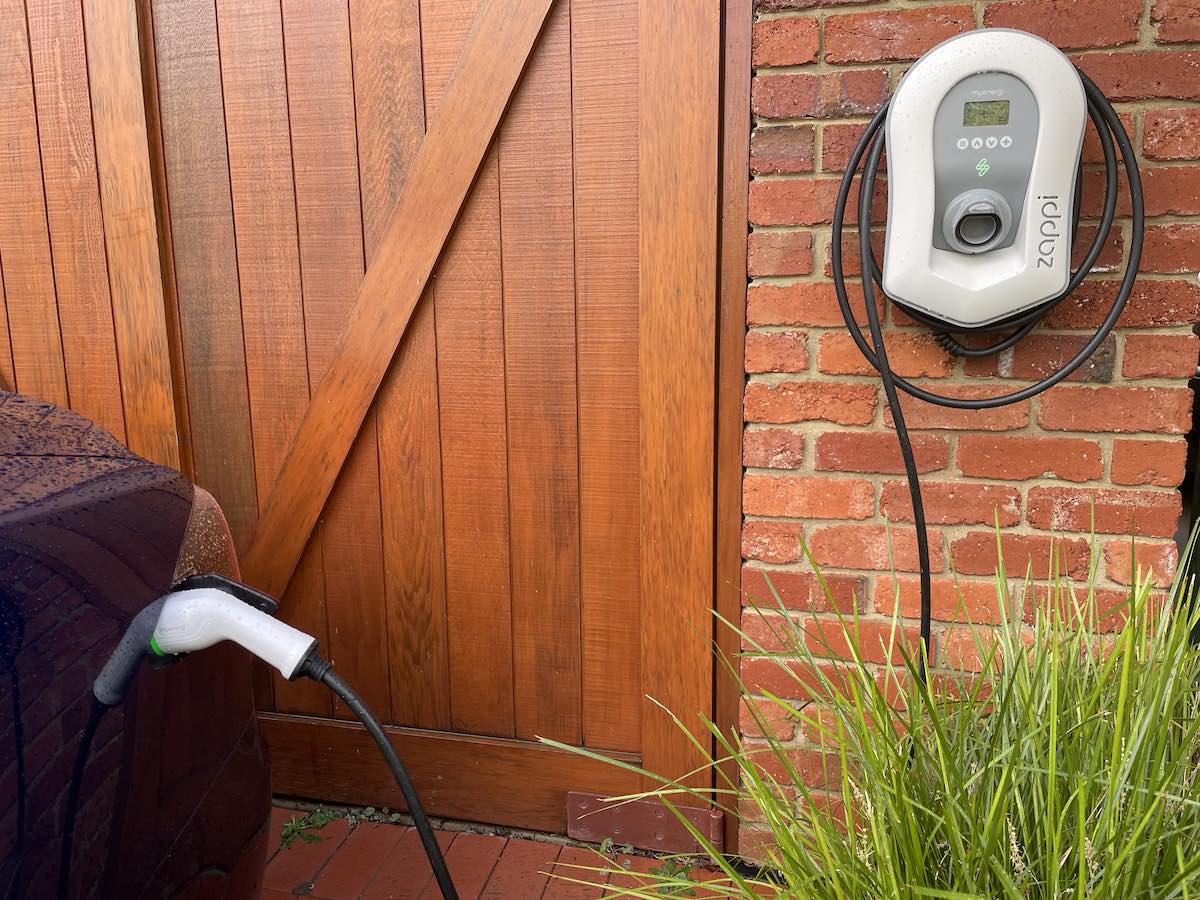
A hard-wired level 2 home charger.
It’s also possible to buy a solar inverter with an integrated Level 2 EV charger, such as this one from SolarEdge:
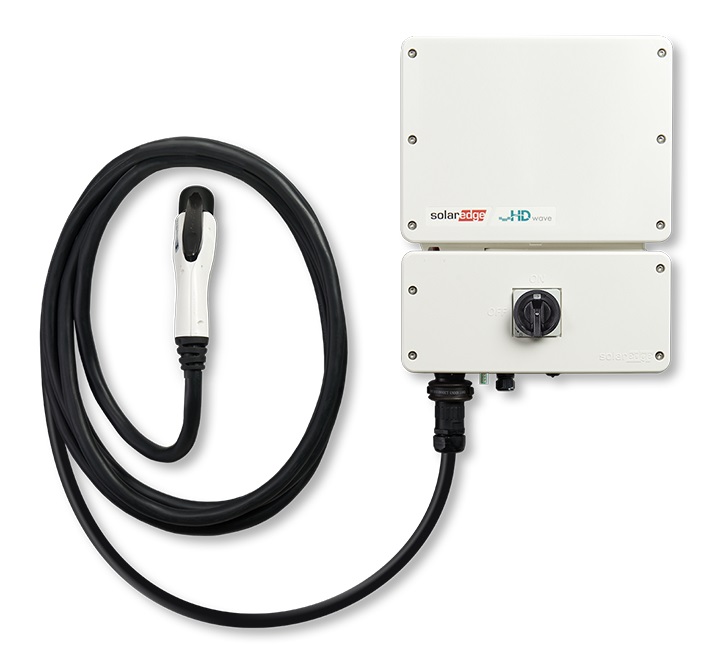
You can check out the specs of this inverter here. Note this has a rated output of 7.4 kilowatts of AC power. It doesn’t supply DC current for higher charging efficiency. Solar inverters able to supply DC power to electric vehicles may appear in the future, but I wouldn’t hold my breath.
Level 2 charging is much faster than Level 1. Just how much faster depends on whether it’s connected to single-phase power or 3 phase power:
- Single-phase EV charger: ~ 4 times faster than Level 1.
- Three-phase EV charger: ~ 6 times faster than Level 1 for most EVs, but ~ 12 times faster with some electric vehicles.
The drawback of level 2 chargers is they cost money4. They start with an installed cost of around $1,500 for a basic model and can easily cost twice that if you want something smart. For this reason, you can save money by sticking with Level 1 charging. But, unless you’re well organized and certain you’ll be happy only using Level 1, my rule of thumb is:
Of course, if you’re not sure you want one, you can always try getting by with Level 1 for a month or two before making a decision.
Single-Phase Level 2 Charging
If your home has single-phase power, you can only install a single-phase home charger. They can generally supply just over 7 kilowatts of power, but the maximum amount will depend on what model you buy. Some can provide 7.4 kilowatts, while others may be 7.2 kilowatts or less. All else equal, more power is better. But there is less than 3% difference between 7.2 and 7.4, so if all else isn’t equal, don’t be too worried about the difference.
For a Tesla Model 3 SR+, a 7.4 kilowatt single phase home charger would be able to…
- Provide around 50km of range in one hour.
- Fully charge its 60 kilowatt-hour battery pack from 0-100% in around 8 hours 50 minutes.
If an EV is driven the Australian daily average of 38km, one hour of single-phase level 2 charging will be more than enough to add that range no matter what type of EV it is — so long as it’s a passenger car and not a semi-trailer.
Three-Phase Level 2 Charging
A three-phase home EV charger can only be installed on a property with 3 phase power. Upgrading to three-phase is an option, but this may cost a couple of thousand dollars or, depending on location, potentially much more. I generally wouldn’t recommend spending that much, unless you have another reason for wanting 3 phase power or you’re determined to have the fastest EV home charging available.
If you have 3 phase power, you don’t have to get a 3 phase EV charger. You can get a single-phase one installed, which will be slower but potentially cheaper.
A 3 phase home charger can generally provide up to 22 kilowatts of power, which is three times more than a single-phase unit. But if I plug it into a Tesla Model 3 SR+, instead of charging three times faster it will only be 1.5 times faster. In other words:
- Provide around 75km of range in one hour.
- Fully charge its 60 kilowatt-hour battery pack from 0-100% in around 6 hours.
The reason why it’s only 57% faster than a 7.4 kilowatt single-phase EV charger is that the Model 3’s onboard charging unit can only accept a maximum of 11 kilowatts. But cars with larger onboard chargers can add range at a faster rate. A new Tesla Model S can accept 16.5 kilowatts, while a Renault Zoe is one of the few electric vehicles that can accept a full 22 kilowatts from a 3 phase level 2 charger.
3 Phase EV Chargers Are Useless For Some EVs
Some electric vehicles will give you no benefit from 3 phase home charging because their onboard chargers simply aren’t large enough. I’ve put some examples below, along with the size of their onboard charger and how many kilometres of range it can supply in one hour. The figure in brackets is the size of the battery pack in kilowatt-hours:
- Hyundai IONIQ Electric (38.3kWh): 7.2 kilowatts – 47km
- Hyundai Kona Electric (38kWh): 7.2 kilowatts – 46km
- MG ZS EV Standard Range (39 kWh): 6.6 kilowatts – 36km
- Nissan Leaf (39kWh): 3.6 kilowatts – 22km
- Nissan Leaf e+ (59kWh): 6.6 kilowatts – 38km
If you have one of these cars you won’t add range faster with a 3 phase home charger. But you may want to get a 3 phase unit anyway to future-proof your home for when you do get a faster charging car.
The onboard charger of the Nissan Leaf is especially weak. However, the Nissan Ariya, which will become available in Japan this week, can charge at a full 22 kilowatts.
Factors Affecting Range & Charging Time
All the ranges I’ve given are based on figures from the European EV Database. Because they don’t have information on how Australia’s hotter weather will affect driving, I’ve used their figures for fair-weather driving and these assume climate control is not used. Using heating or cooling will slightly reduce an EV’s range.
How you drive will also have an effect, with little old grannies getting more distance than revheads per kilowatt-watt. Except for my granny, a complete hoon who was banned from Myers for dropping donuts in the underground car park.
While using climate control will modestly reduce the range, both hot and cold weather can reduce charging efficiency and increase times. This is because the EV can spend energy either cooling down or heating up its battery pack so it can be safely charged. Generally, energy is only spent heating batteries when it’s below 10ºC, so losses from this should not be high in Australia. It’s not yet clear how our warmer than average climate will affect EV charging efficiency, but I haven’t heard EV owners here complain so far.
The EV Database figures I’ve used are for combined city and highway driving. If you’re staying in town you can expect to get around 30% more range per hour of charging than estimates in this article. If you’re hitting the highway, the range may be around 20% less. Note this is the opposite of how internal combustion engine vehicles behave, as their range is worse in the city and better on the highway.
How Fast You Can Charge An EV
Here’s a list of Australia’s most popular electric cars — and a few unpopular ones5 — showing approximately how many km of range they will gain in one hour when charged with:
- A 7.4 kilowatt single phase charger.
- A 22 kilowatt 3 phase charger.
While the EV Database gives real-world figures for range, they don’t do the same for charging efficiency, so I’ve assumed all the electric vehicles have 88% efficiency for both single-phase and 3 phase.
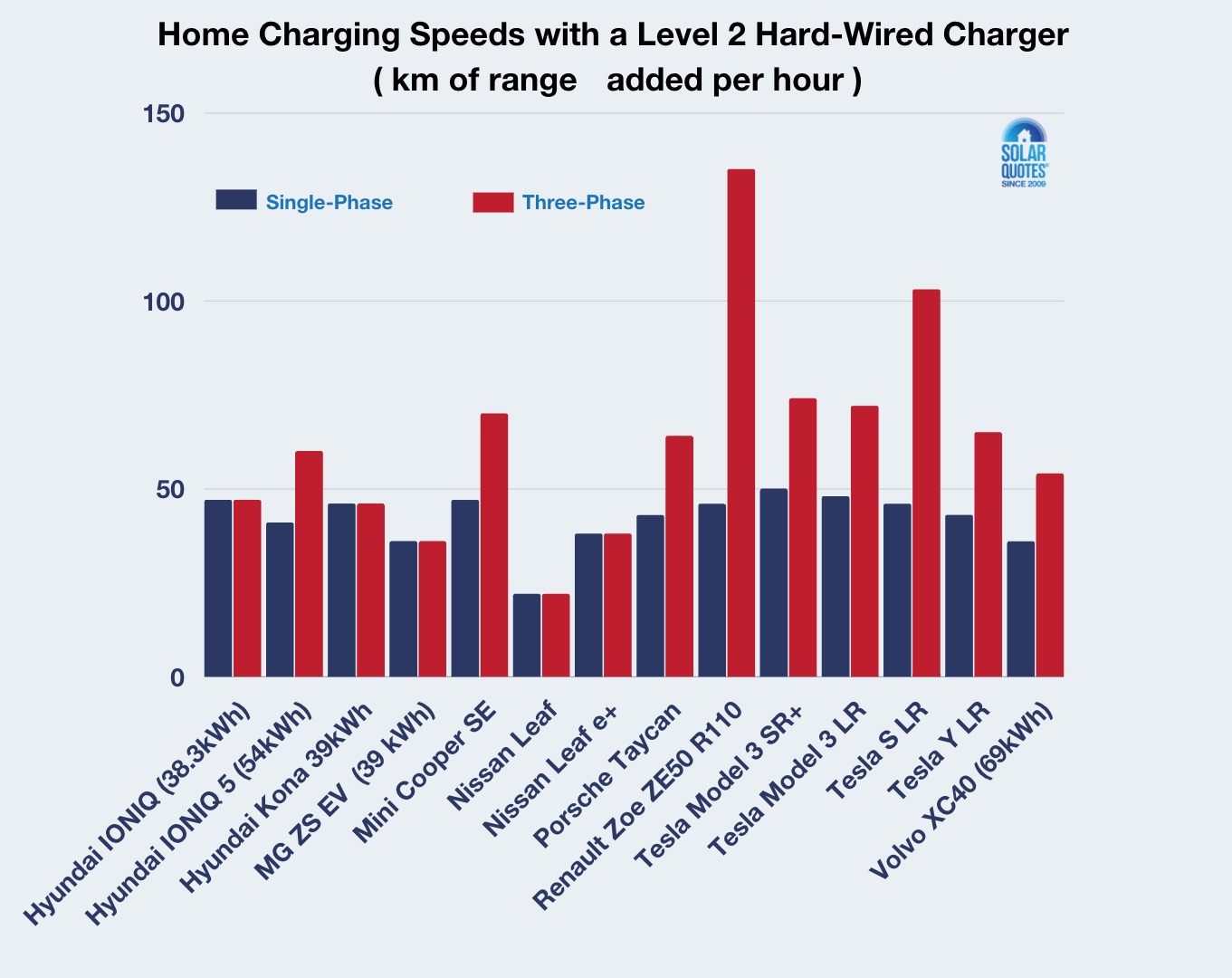
If you want to charge quickly from 3-phase at home, buy a Renault Zoe.
A Quick Finish
Now you know the fastest way to charge an electric vehicle at home and have approximate figures for how much range a home charger can add in an hour for a slew of electric vehicles. Whether or not it makes sense to charge fast is something you’ll have to decide for yourself — for now.
I could give you my thoughts on the topic, but first I’ll have to think them, and then I’ll have to put them in order. That may take a while because I have COVID brain at the moment. That is, I’m putting 90% of my mental effort into avoiding COVID. It’s worked so far, but as I didn’t have much mental effort to begin with, it’s taking a toll.
But at least I was able to scrape together enough brain energy to tell you the fastest way for someone at home to get juice into their EV.

WARNING! Never put juice or any other liquid into your EV battery pack.
Footnotes
- Hyundai says 111km for the Ioniq 5 Long Range, but that assumes no climate control is used, so 100km is more realistic. ↩
- If it’s to bring the dead to life through the application of electrical energy… Well, everyone needs a hobby. ↩
- Many Level 1 connectors can also be used with a 15 amp powerpoint, which can allow moderately faster charging, but few properties have them. ↩
- Added June 8, 2022: We’ve recently created a tool where you can easily compare EV chargers side-by-side on specifications and cost ↩
- Many electric vehicles would be far more popular if available in adequate numbers without long waiting times. ↩

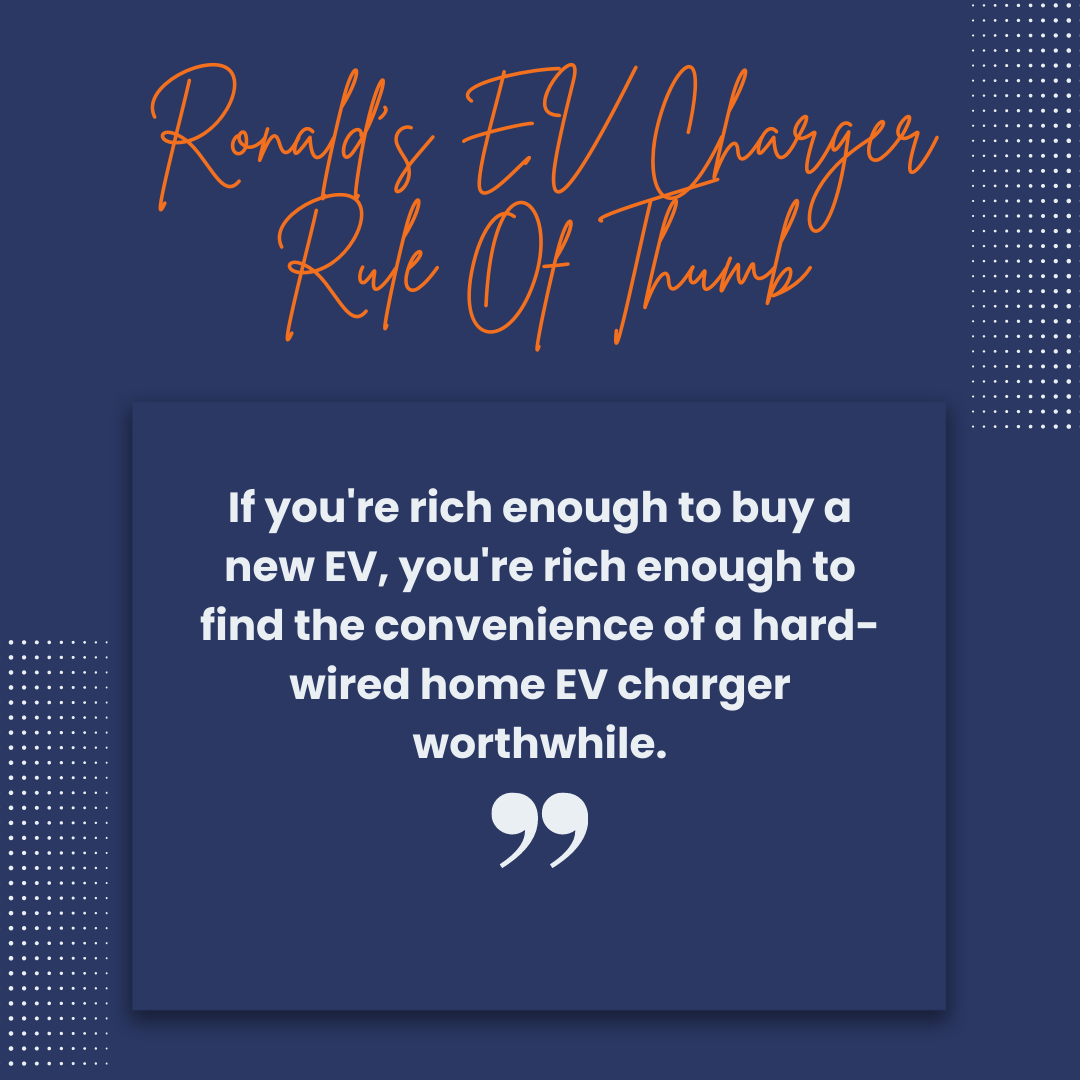

 RSS - Posts
RSS - Posts



Surely level 1 is 10A X 240V = 2.4kW (give or take)?
Also in QLD at least you can only have 20A (4.6kW) unless it is on a controlled load. So if you want to charge when it suits you from a home wallbox, you can’t have 7kW.
Unfortunately, level 1 chargers are often limited to 8 amps for safety so it comes out closer to 1.5 kilowatts after including losses. This means the EV battery pack will gain roughly 1.5 kilowatt-hours per hour of charging.
I am not qualified to do electrical work in QLD, so don’t take my word on this, but my understanding is “uncontrolled equipment” is generally limited to 20 amps, but a hardwired EV charger counts as “controlled equipment” and generally has a limit of 35 amps. Page 30 of the Queensland Electricity Connection Manual goes into this:
https://www.ergon.com.au/__data/assets/pdf_file/0004/45994/NA000403R509-QECM.pdf
The granny charger that came with my Hyundai was switchable up to 10A.
The guy from Jetcharge told me about the limit but I’m keen to find out if that has changed.
“The charger is set at 4.5kW (20A) due to the restrictions in QLD by the power distributors, Energex & Ergon. The restriction is any EV charger at home cannot exceed 20A single phase (4.5kW).”
OK I just did some googling and found this:
“Our Queensland Electricity Connection Manual (PDF 5.1 mb) provides rules on the connection of equipment such as wall-mounted EV chargers. A typical 7kW (~32 Amp) single-phase EV charger can’t be connected to a continuous supply (uncontrolled) tariff. It can only be connected to an economy, or controlled, tariff.
An economy tariff is available for at least 18 hours per day, and often only switched off for short periods in the morning and/or early evening, so your EV battery will still be fully or mostly charged when you need it to be.
If you want access to 24/7 charging at home at charging rates above 20A (~4.6 kW), your only option is to upgrade your electrical installation to 3-phase, and buy and have installed a 3-phase charger. However, this is only viable if your EV can accept a 3-phase charge.”
https://www.ergon.com.au/network/smarter-energy/electric-vehicles/charging-your-electric-vehicle
You can also get a 15A Powerpoint like I have at home and a 15amp Level 1 charger which will give you 3.6kW. But realistically that’s about 18 – 20 kms/h after losses
BTW – they aren’t chargers until you get to Level 3 – the AC chargers are in the car and that’s why not all cars are equal. The Level 1 and Level 2 unit is just a way of getting AC to the charger and negotiating the correct current level. It’s an EVSE. Electric Vehicle Supply Equipment.
No Ronald, newer Tesla wall chargers will do the full 10A (or the full 15A on a 15A socket.)
SO in other words they will do 10A/2.4kW and 15A/3.6kW.
They have temp monitoring in the 3 pin plug, (which will reduce the current or even stop charging if overheating is detected) though it’s not much use if you use an extension lead as the temp monitor is only at the plug on the actual Tesla UMC.
However it’s always wise to use a slightly lower amperage on circuits where there may be other loads for some more safety margin.
It’s a very good reason to have a dedicated charging circuit.
A new circuit in good condition, with no other major appliances connected, and power outlet (GPO) in good condition, should handle 10A without any issue.
However if anything is degraded due to age, or there are other power hungry devices attached, could lead to overheating issues.
So, caution is advised.
I think Ronald was talking about mobile EVSE’s and I assume you are too – you can’t connect the Tesla wall charger to a normal socket. It requires a separate circuit and an electrician. AFAIK.
John- I’m talking about the (supplied with the car) Tesla mobile UMC.
It comes with two standard plugs: a 10Amp 3 pin plug, and a 15A 3 pin plug.
Earlier versions were limited for a safe margin to 8A and 12A, but are now capable of 10A and 15A, though can be used with a lower current which can be selected in the car OR on the phone App.
(You can also buy a 32A plug for the same UMC, which will give the potential for 32A single phase charging -ie: 7kW- with a suitable socket.)
The wall charger is purchased separately, can supply single OR 3 phase power, at up to 32A and is normally hardwired.
Hi,
I’ve just had the Ocular smart charger 3 phase installed at home.
The home is 3 phase.
The ev is a BYD Atto3.
The car in any of the two solar modes will only charge to a maximum of 1.5kwt same as a trickle charger, whilst still exporting back to the grid up to 7kwts excess back to grid.
The car is single phase only to charge.
Does this mean it will only ever charge to 1.5 kwts of solar?
Hi Tom,
Can you tell us the model number of the charger so we might look up the details. At first blush I would think the setup isn’t quite correct. Perhaps the CT coils which measure the grid input/output aren’t in the right place(?) What might be happening is the Ocular charger is detecting solar export and diverting that energy to the EV, but because it’s balanced across 3 phases you’re only seeing 1.5kW into the car on a single phase.
Correct- in Qld you are indeed limited to 20A unless you’re on controlled load.
Makes sense- they don’t want people arriving home at 5pm and pulling high current during the evening peak.
(Anybody with half a brain will charge either when solar is really pumping or when the grid is under no stress for example after midnight. However that assumes that people care about such things, …. and many don’t. TOU tariffs are the only thing which will modify the behaviour of such people.)
Might be of interest to SQ: https://www.news.com.au/technology/environment/how-electrification-could-save-you-4700-on-power-bills/news-story/4b6d3cd587d348f1463400e48a9b016a
I can’t fathom their accounting however. To save $4,700 on electricity bills as they claim would require power consumption of roughly 19,000 kWh per year, and assumes no change in supply charges.
That’s roughly a tripling of the current average, or about 6x the global average. Why not advocate for smarter (more expensive) builds than greater power usage?
The numbers are sound and all published:
https://global-uploads.webflow.com/612b0b172765f9c62c1c20c9/615a1e5c7bec5c70d6d3f346_Castles%20and%20Cars%20Rewiring%20Australia%20Technical%20Study.pdf
The electricity usage increases because everything – all driving, cooking, water heating and space heating is electrified. This is a good thing because it reduces our primary energy usage – because electric cars and heat pumps are so much more efficient than liquid fuel and gas.
Thanks for the link. Will save my reply for the new article Michael has done on this.
I charge my Nissan Leaf at home using a KHONS 6/10/15 watt charger that plugs into a dedicated 15amp wall socket.
When set to 15amps a full charge only takes a few hours (6?).
We’ve had our Leaf for 12 months now travelled 10,000 k (including a trip to Melbourne) and spent less than $100 on electricity charging as we use the home charger when the sun is shining on our PV.
Any comment on the use of the charger (eg which wattage is best) to maximise battery health and life would be appreciated. Still learning.
I have been using the 10A chargers for abt 8 years: An Imiev, then 2 yrs ago a Kona.. On both the Imiev & the Kona, the 10A charger adds abt 15Km/hr.
Something not mentioned is that the 10A power points & wiring run warm!
All connections must be clean or the plugs/sockets can melt (Experience…)
NEVER recommended to run a 10A charger on an extension lead (even a really heavy builders lead can run warm & no loops!)
I am currently checking out ZJ Beny chargers (that also supply to Tesla…).
They do a model with OCPP (which allows your retailer to switch off power during excessive peak demand periods. Also should give you a good discount with your energy retailer), & DLM that allows (Dynamic) Load management & another option of monitoring Solar PV. All for under $800 for the all bells & whistles model. The Cheaper version misses all the goodies.
Installation is not cheap because heavy cable is required, & must be cabled back to the board with possible expensive ELCB (that checks DC leakage).
I like the idea of a Solar carport, with an inverter with EVSE included (such as the SolarEdge shown). There is no reason that recycled Solar panels
could not be used on a solar carport. 300W panels on 4M x ~8M carport
give abt 8Kw, added to a bit from the grid= cheap charge!
btw, watch some of the Environmental groups for bulk buys on EVSE chargers! There are already Bulk buys on cars (Enova has a link with The Good Car Co for imported used EVs, as well as discounts on New EVs.), so
EV chargers will follow.
Another point is to buy a type 2 to car 7.2Kw cable to carry in the car: In Qld, on the EV Highway, there are Type 2 chargers as well as Fast Chargers. You can use the T2 if the Fast is busy, or inoperable. Also many Supermarket chargers also require your own cable. (Type 2>Type 2 cable abt $250-$300, but worth it. Beware the low current ones, because they slow the charge rate!)
Many brands of EVSE’s have the necessary RDC-DD inbuilt and can be protected by a basic Type AC RCBO used in domestic applications.
Sparky Direct – $28 for a single phase, 32A RCBO Type AC – CLIPSAL RCBE232/30S
Of course, if your chosen EVSE does not have the RDC-DD inbuilt, you need a Type B RCD, which is much more expensive .. like $500.
I’m not aware of a single phase all-in-one solution, so . it’s a 2piece solution.
The ZJ Beny includes a Type B RCD built-in, which covers both DC and AC currents. Of course, it’s always prudent to include a Type A at the switchboard, if for nothing else isolation purposes.
Informative article! Just a comment about the use of the word “charger” that had me very confused as a newbie – the box on the wall or cable supplied with the car, is NOT a charger, it’s an interface or “controller” for the charger that exists in the car. It connects power from the mains, monitors various things, adjusts current to suit the supply/car capability.
Digging deeper, God knows why EVSE units are so expensive, various controller “brain” modules with the other parts, can be bought online for a couple of hundred dollars.
The flex cable is also expensive if you can find it, it’s a special in that it has 5 heavy cores plus 2 much smaller control cores (3 phase version).
I guess prices will drop as more manufacturers start producing it.
“Many Level 1 connectors can also be used with a 15 amp powerpoint, which can allow moderately faster charging, but few properties have them.”
I think it would be wise to have at least one 15 amp GPO on residential properties near where vehicles are parked.
There are portable type 1 / 2 EV chargers with Selectable Charge Rate between 6, 10 and 15 amps available, fitted with 15 amp Australian plug (larger Earth pin). Up to 3.6kw charging rate or approx. 15-20km of range per hour.
Example: https://www.evolutionaustralia.com.au/product-page/portable-evse-ev-charger-10a-15a-switchable
If only a 10 amp GPO is available (say when charging overnight away from home), then a power adapter can be used, like the range of Ampfibian 15A To 10A Power Adaptors (for indoor, undercover and weatherproof applications).
https://ampfibian.com.au/store/
I suspect any legal 15A to 10A power adaptor is not going to allow you to charge at 15A in a 10A socket. All of these devices I am aware of (including the ones in the link if you look at the specifications) will have their own inbuilt 10A breaker, and will be tripping at around 10A. This is to avoid the risk of starting fires in circuits only designed for 10A. They are really only to allow you to using your 15A extension leads etc to plug into 10A sockets if that is all that is available. But you will need to keep you current draw below 10A to avoid tripping the breaker.
There are some people who might think they have some sort of safe magic in them to allow a 10A power point to draw 15A safely, as they have used them and their loads seem to work. However, this will probably because while the appliance has a 15A plug, it might not draw over 10A enough to trip the breaker.
Matthew,
“I suspect any legal 15A to 10A power adaptor is not going to allow you to charge at 15A in a 10A socket.”
Correct. It should still allow the use of a portable type 1 / 2 EV charger, like the example given in my earlier comment, in conjunction with the power adaptor, drawing current at either the 10A or 6A selectable settings (but not the 15A setting).
When a 15A GPO is available, the 15A to 10A power adaptor is not required. Plug-in the portable type 1 / 2 EV charger directly and have the choice of all settings available – 6A, 10A or 15A.
Ron, just a note about the Renault Zoe.. there was this article about 3 years ago re the Zoe and Kangaroo, not recommending trickle charging as it would/could void the battery warranty. Then I saw a follow up article saying there was a technical reason because of the configuration of the guts of the car. Not sure if this is still valid. And a bit academic as Zoe still! Not available in Australia
https://www.drivezero.com.au/cars/renault/renault-australia-tells-customers-their-warranty-may-be-void-if-they-use-a-portable-ev-charger/
Now it doesn’t bother me, due to the configuration of my block of units, I can’t safely charge at home, even if we had solar panels. A second hand Zoe would suit me down to the ground. If I live that long.
Lastly, can you advise people about the safety of using extension cords to trickle charge. I’ve seen advice that it is not safe, and people need to be aware if that is so.
So why Tesla’s charging cable has 10A and 15A “adapters” if it runs at 8A only? 10A plug fits into 15A socket. Or – maybe it can work with over 8A?
Tesla mobile connectors supplied in Australia after November 2021 supply at the full 10A or 15A depending on the tail used.
Strange. 2 months ago we had a test drive of a new Model 3 LR from Tesla overnight, and testing the charging speed with the 10A and 15A plugs. With both, the charge speed was significantly less than the 10A and 15A peak potential. I can’t remember the specifics now, but I think it was about 1900W and about 3000W respectively. This was measured both by the Tesla, but also an accurate power meter plugged directly into the connector. And this was despite higher voltage here of just short of 250V at the time. So all of this is well short of the 10A/15A potential.
What do you think is the explanation for this? Do you think they had thrown in and old version of the plug or something. It looked new, and looked like it would have been the one that came with the car. But maybe there was a bit of swapping around?
There’s nothing “strange” about it at all.
Earlier versions were limited to 8A and 12A.
That gives a good safety margin
Later ones can charge at the full 10A and 15A, usually fine as the temp in the plug is monitored, and the charge current will automatically reduce or even cut off if overheating is detected in the plug. (The problem can however arise if other devices are used including Ampfibian and/ or extension leads.)
If you have 3 phase power then you should probably get a 3 phase charger to spread the load across all 3 phases.
I’d be interested in extension of the blog to PHEV’s and discussion of V2H and V2G. I’ve got an Outlander with ~13kwh battery and charge it from 240v 10A outlet only when I’m producing plenty of solar between 9:00 and 15:00. This works fine for me as I don’t commute every day. My next step might be to do V2G or V2H which Outlander (and Leaf) can do. But the equipment to do that is very expensive atm so I got a Powerwall instead. Not sure, but people who don’t want to invest in a loss making home battery might do the V2H approach and get faster charging as a bonus?
Having owned a PHEV previously, I wouldn’t ever consider V2G or V2H even if I had the equipment (except in emergency).
The PHEV had horrible battery degradation without ever using it for other uses as you’re suggesting. The battery is just too small, and the BMS software is rubbish.
At the moment a Powerwall is a much smarter way to spend your money.
The other thing is that Chademo is all but dead and buried, like Beta vs VHS. It’s the last thing I’d want in a new EV.
Level 2 home chargers such as the Zappi also supposedly have the ability to only charge when solar would otherwise be exported to the grid. In my situation, if I want to use this feature, as I understand it, the max charging rate will be limited by the size of my inverter – 5kW. From this maximum rate I would need to subtract power being consumed in the house, reducing the charging rate to say 4kW per hour. I’ve wondered if it may be better to get a 15 A plug put in at a much cheaper cost, that will give me ~ 3.6 kW per hour. Is my logic correct?
Next logical article would be on V2H
VtoH seems the way to go for me. Dont do much driving (so battery life should be OK), dont use a lot of electricity, but probably 1/3 is at night (so V bat should provide that). I envisage no (or minimal grid supply cost) and no V fuel cost. Useage is low because of gas stove, and Controlled Use rate for HW.
The big killer for me (as a small user) is the amount charged for supply (poles and wires). Last month it was 41% of my bill!
Why go solar? Not to save money but to be ‘in the swim’, and not care about about useage cost. BTW, I wouldnt go for V to G. The feed in rate is low and sure to get lower as more wind and sun comes on line. I would reinstall air-con – its mostly NOT reverse cycle.
When a suitable car is available, plus the necessary compatible inverters, I will go all in at once – panels & car. Totally indiscriminate spend of $ before I pass!
The other option not mentioned is portable 3 phase chargers. We have installed an outdoor 3 phase powerpoint in the driveway on a dedicated circuit. We use this portable 3 phase charger to charge our EV: KWIK Portable Type 2 Charger | 32 Amp | 22kW.
It’s excellent, costs less than a wall charger and our 70kw EV battery charges at 11kw from 20% to 90% within 5 hours. We can also take the charger with us and use it wherever there is a 3 phase outlet.